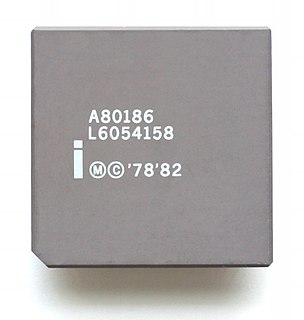Related Research Articles

The Intel 80286 is a 16-bit microprocessor that was introduced on February 1, 1982. It was the first 8086-based CPU with separate, non-multiplexed address and data buses and also the first with memory management and wide protection abilities. The 80286 used approximately 134,000 transistors in its original nMOS (HMOS) incarnation and, just like the contemporary 80186, it could correctly execute most software written for the earlier Intel 8086 and 8088 processors.

The Intel 8080 ("eighty-eighty") is the second 8-bit microprocessor designed and manufactured by Intel. It first appeared in April 1974 and is an extended and enhanced variant of the earlier 8008 design, although without binary compatibility. The initial specified clock rate or frequency limit was 2 MHz, with common instructions using 4, 5, 7, 10, or 11 cycles. As a result, the processor is able to execute several hundred thousand instructions per second. Two faster variants, the 8080A-1 and 8080A-2, became available later with clock frequency limits of 3.125 MHz and 2.63 MHz respectively. The 8080 needs two support chips to function in most applications: the i8224 clock generator/driver and the i8228 bus controller. It is implemented in N-type metal-oxide-semiconductor logic (NMOS) using non-saturated enhancement mode transistors as loads thus demanding a +12 V and a −5 V voltage in addition to the main transistor–transistor logic (TTL) compatible +5 V.

The 8086 is a 16-bit microprocessor chip designed by Intel between early 1976 and June 8, 1978, when it was released. The Intel 8088, released July 1, 1979, is a slightly modified chip with an external 8-bit data bus, and is notable as the processor used in the original IBM PC design.

The Intel 8088 microprocessor is a variant of the Intel 8086. Introduced on June 1, 1979, the 8088 has an eight-bit external data bus instead of the 16-bit bus of the 8086. The 16-bit registers and the one megabyte address range are unchanged, however. In fact, according to the Intel documentation, the 8086 and 8088 have the same execution unit (EU)—only the bus interface unit (BIU) is different. The original IBM PC is based on the 8088, as are its clones.

The Intel 386, originally released as 80386 and later renamed i386, is a 32-bit microprocessor introduced in 1985. The first versions had 275,000 transistors and were the CPU of many workstations and high-end personal computers of the time. As the original implementation of the 32-bit extension of the 80286 architecture, the i386 instruction set, programming model, and binary encodings are still the common denominator for all 32-bit x86 processors, which is termed the i386-architecture, x86, or IA-32, depending on context.

The Intel 80186, also known as the iAPX 186, or just 186, is a microprocessor and microcontroller introduced in 1982. It was based on the Intel 8086 and, like it, had a 16-bit external data bus multiplexed with a 20-bit address bus. The 80188 variant, with an 8-bit external data bus was also available.

The Intel 80188 microprocessor was a variant of the Intel 80186. The 80188 had an 8-bit external data bus instead of the 16-bit bus of the 80186; this made it less expensive to connect to peripherals. The 16-bit registers and the one megabyte address range were unchanged, however. It had a throughput of 1 million instructions per second. Intel second sourced this microprocessor to Fujitsu Limited around 1985.

The StrongARM is a family of computer microprocessors developed by Digital Equipment Corporation and manufactured in the late 1990s which implemented the ARM v4 instruction set architecture. It was later sold to Intel in 1997, who continued to manufacture it before replacing it with the XScale in the early 2000s.

The Intel 8085 ("eighty-eighty-five") is an 8-bit microprocessor produced by Intel and introduced in March 1976. It is a software-binary compatible with the more-famous Intel 8080 with only two minor instructions added to support its added interrupt and serial input/output features. However, it requires less support circuitry, allowing simpler and less expensive microcomputer systems to be built.

Chips and Technologies (C&T), founded in Milpitas, California in December 1984 by Gordon A. Campbell and Dado Banatao, was an early fabless semiconductor company.

The Intel 8259 is a Programmable Interrupt Controller (PIC) designed for the Intel 8085 and Intel 8086 microprocessors. The initial part was 8259, a later A suffix version was upward compatible and usable with the 8086 or 8088 processor. The 8259 combines multiple interrupt input sources into a single interrupt output to the host microprocessor, extending the interrupt levels available in a system beyond the one or two levels found on the processor chip. The 8259A was the interrupt controller for the ISA bus in the original IBM PC and IBM PC AT.

Multibus is a computer bus standard used in industrial systems. It was developed by Intel Corporation and was adopted as the IEEE 796 bus.
Tolapai is the code name of Intel's embedded system on a chip (SoC) which combines a Pentium M (Dothan) processor core, DDR2 memory controllers and input/output (I/O) controllers, and a QuickAssist integrated accelerator unit for security functions.

Intel 8237 is a direct memory access (DMA) controller, a part of the MCS 85 microprocessor family. It enables data transfer between memory and the I/O with reduced load on the system's main processor by providing the memory with control signals and memory address information during the DMA transfer.

The U80601 was a 16-bit microprocessor made in 1989-1990 by Kombinat Mikroelektronik Erfurt in the former German Democratic Republic of East Germany. It was manufactured in NMOS technology and encased in a PLCC or ceramic (CLCC) package.

The Intel 8089 input/output coprocessor was available for use with the 8086/8088 central processor. It was announced on May 1979, but the price was not available at that time. It used the same programming technique as 8087 for input/output operations, such as transfer of data from memory to a peripheral device, and so reducing the load on the CPU. This I/O processor was available on July 1979 for US$194.20 in quantities of 100 or more. Intel second sourced this coprocessor to Fujitsu Limited.

The High-Performance Graphics Display Controller 7220 is a video display processor capable of drawing lines, circles, arcs, and character graphics to a bit-mapped display. It was developed by NEC in order to support the Kanji character set efficiently, which explains why the APC computer line had such superior graphics compared to competing models. The chip was also used in later computers, such as the NEC N5200, PC-9801 APC II and APC III computers, the NECcomputer, the optional graphics module for the DEC Rainbow, the NCR Decision Mate V, the Tulip System-1, and the Epson QX-10.

The Intel 8284 is a clock oscillator chip developed primarily for supplying clock signals for the Intel-8086/8087/8088/8089 series of processors. The commercial variant of the chip comes in 18-pin DIL and 20-pin PLCC packages, and originally was priced at $4.90 USD. The industrial version, rated for the temperatures range of -40 °C to +85 °C was priced at $13.50 USD. The available 82C84A CMOS version was outsourced to Oki Electronic Industry Co., Ltd.

The Intel 8288 is a bus controller designed for Intel 8086/8087/8088/8089. The chip is supplied in 20-pin DIP package. The 8086 operate in maximum mode, so they are configured primarily for multiprocessor operation or for working with coprocessors. Necessary control signals are generated by the 8288. It was used in the IBM PC, XT and its clones. IBM PC AT used its successor Intel 82288.